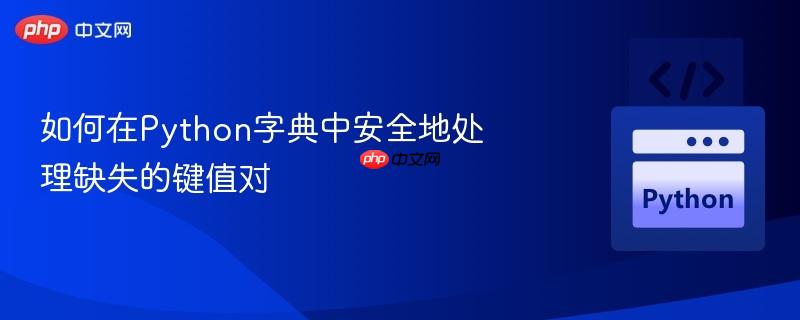
本文探讨了在Python中访问字典时,如何避免因键不存在而引发`KeyError`的问题,特别是当使用三元条件表达式处理嵌套字典时。文章详细介绍了使用`in`操作符检查键是否存在,以及利用`dict.get()`方法提供默认值这两种安全高效的策略,确保代码在处理不确定数据结构时更加健壮。
在Python编程中,处理从外部源(如API响应、配置文件)获取的数据字典是常见任务。这些数据结构可能不总是包含所有预期的键,尤其是在嵌套字典的情况下。直接访问一个不存在的键会导致KeyError,从而中断程序执行。本教程将深入探讨如何安全地访问字典中的键,特别是当键可能缺失时,并提供几种健壮的解决方案。
KeyError通常发生在尝试使用方括号语法(dictionary['key'])访问字典中不存在的键时。例如,考虑以下两种字典结构:
# 示例数据结构1:包含 'portal' 键
data_with_portal = {
"Other_Key_1": "Other_Value_1",
"portal": {
"isHosted": False,
"portalServer": [
{"type": "PHP", "itemID": "hshshdkdkd"},
{"type": "ASP", "itemID": "5s55s5s5s"}
]
},
"Other_Key_2": "Other_Value_2"
}
# 示例数据结构2:不包含 'portal' 键
data_without_portal = {
"Other_Key_1": "Other_Value_1",
"Other_Key_3": "Other_Value_3"
}如果尝试使用如下三元条件表达式来获取portal键下的isHosted值:
立即学习“Python免费学习笔记(深入)”;
# 假设我们正在处理 data_with_portal 或 data_without_portal # 这是一个常见的错误尝试 # status = data['portal']['isHosted'] if data['portal'] != "" else "NA"
当data是data_with_portal时,上述代码可能正常工作。然而,当data是data_without_portal时,data['portal']这一部分在执行条件判断之前就会被评估,由于'portal'键不存在,这将立即抛出KeyError。问题不在于portal的值是否为空字符串,而是portal这个键本身就不存在于字典中。
最直接且推荐的方法是使用in操作符来检查字典中是否存在某个键。这可以安全地集成到三元条件表达式中。
# 使用 'in' 操作符检查顶级键是否存在
def get_portal_status_safe_in(data):
status = data['portal']['isHosted'] if 'portal' in data else "NA"
return status
print(f"Status for data_with_portal (using 'in'): {get_portal_status_safe_in(data_with_portal)}")
print(f"Status for data_without_portal (using 'in'): {get_portal_status_safe_in(data_without_portal)}")输出:
Status for data_with_portal (using 'in'): False Status for data_without_portal (using 'in'): NA
这种方法首先检查'portal'键是否存在于data字典中。如果存在,则执行data['portal']['isHosted'];如果不存在,则直接返回"NA"。这有效地避免了KeyError。
dict.get()方法提供了一种更优雅、更Pythonic的方式来访问可能不存在的键。它接受两个参数:要查找的键和如果键不存在时返回的默认值。
# 使用 dict.get() 方法
def get_portal_status_safe_get(data):
# 先获取 'portal' 字典,如果不存在则返回一个空字典 {} 作为默认值
portal_data = data.get('portal', {})
# 然后从 portal_data 中获取 'isHosted',如果不存在则返回 "NA"
status = portal_data.get('isHosted', "NA")
return status
print(f"Status for data_with_portal (using 'get'): {get_portal_status_safe_get(data_with_portal)}")
print(f"Status for data_without_portal (using 'get'): {get_portal_status_safe_get(data_without_portal)}")
# 考虑 portal 存在但 isHosted 不存在的情况
data_portal_no_isHosted = {
"Other_Key_1": "Other_Value_1",
"portal": {
"someOtherKey": "someOtherValue"
}
}
print(f"Status for data_portal_no_isHosted (using 'get'): {get_portal_status_safe_get(data_portal_no_isHosted)}")输出:
Status for data_with_portal (using 'get'): False Status for data_without_portal (using 'get'): NA Status for data_portal_no_isHosted (using 'get'): NA
dict.get()的优点在于它允许我们优雅地处理多层嵌套的键缺失问题。在上面的例子中,我们首先尝试获取'portal'键。如果它不存在,get()会返回一个空字典{}。然后,我们再从这个(可能是空的)字典中尝试获取'isHosted'键。如果'isHosted'也不存在,则返回"NA"。这种链式调用get()的方式非常适合处理复杂的嵌套数据结构。
对于更复杂的键访问逻辑,或者当你需要执行不同的错误处理策略时,try-except块是一个强大的工具。
def get_portal_status_safe_try_except(data):
try:
status = data['portal']['isHosted']
except KeyError:
status = "NA"
return status
print(f"Status for data_with_portal (using 'try-except'): {get_portal_status_safe_try_except(data_with_portal)}")
print(f"Status for data_without_portal (using 'try-except'): {get_portal_status_safe_try_except(data_without_portal)}")输出:
Status for data_with_portal (using 'try-except'): False Status for data_without_portal (using 'try-except'): NA
try-except块在尝试执行可能引发KeyError的代码时非常有用。如果发生KeyError,程序流程会跳转到except块,从而避免崩溃。虽然对于简单的键存在性检查,in操作符或get()方法通常更简洁,但try-except在处理更广泛的异常类型或需要更精细的错误报告时,提供了更大的灵活性。
在Python中处理可能缺失的字典键时,选择合适的策略至关重要:
在实际开发中,通常推荐优先使用get()方法,因为它代码量少,可读性好,并且能够优雅地处理默认值。对于多层嵌套的字典,可以考虑组合使用get()方法,或者编写辅助函数来安全地获取深层嵌套的值。通过采纳这些防御性编程实践,你可以构建出更加健壮、容错性更强的Python应用程序。

每个人都需要一台速度更快、更稳定的 PC。随着时间的推移,垃圾文件、旧注册表数据和不必要的后台进程会占用资源并降低性能。幸运的是,许多工具可以让 Windows 保持平稳运行。

Copyright 2014-2025 https://www.php.cn/ All Rights Reserved | php.cn | 湘ICP备2023035733号